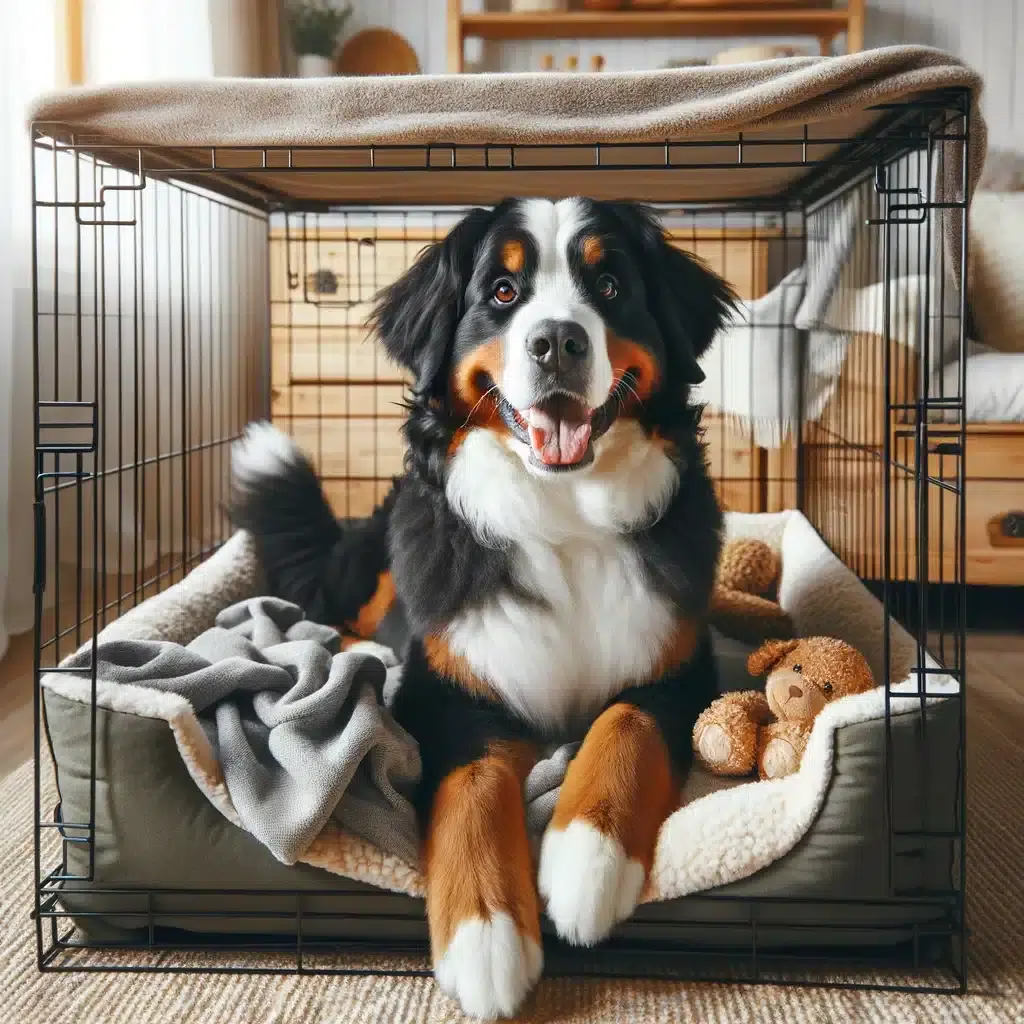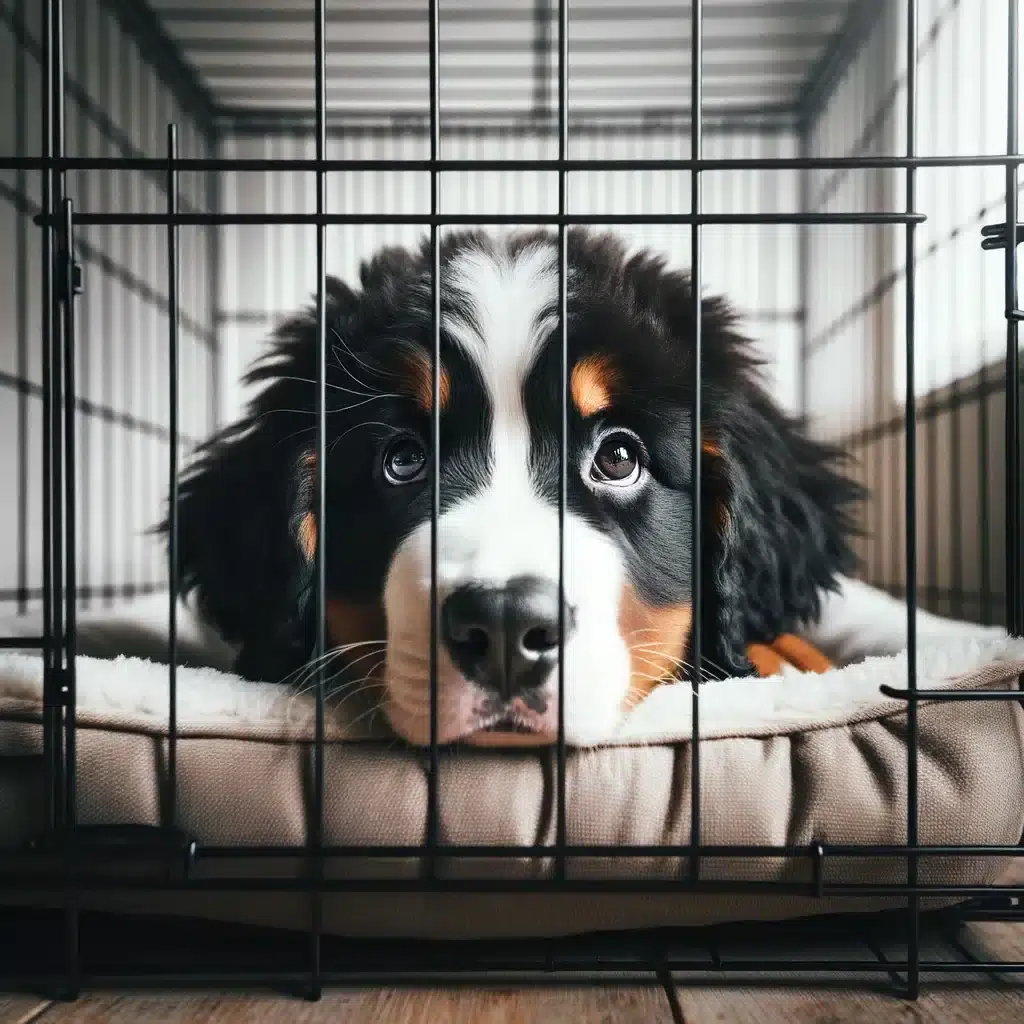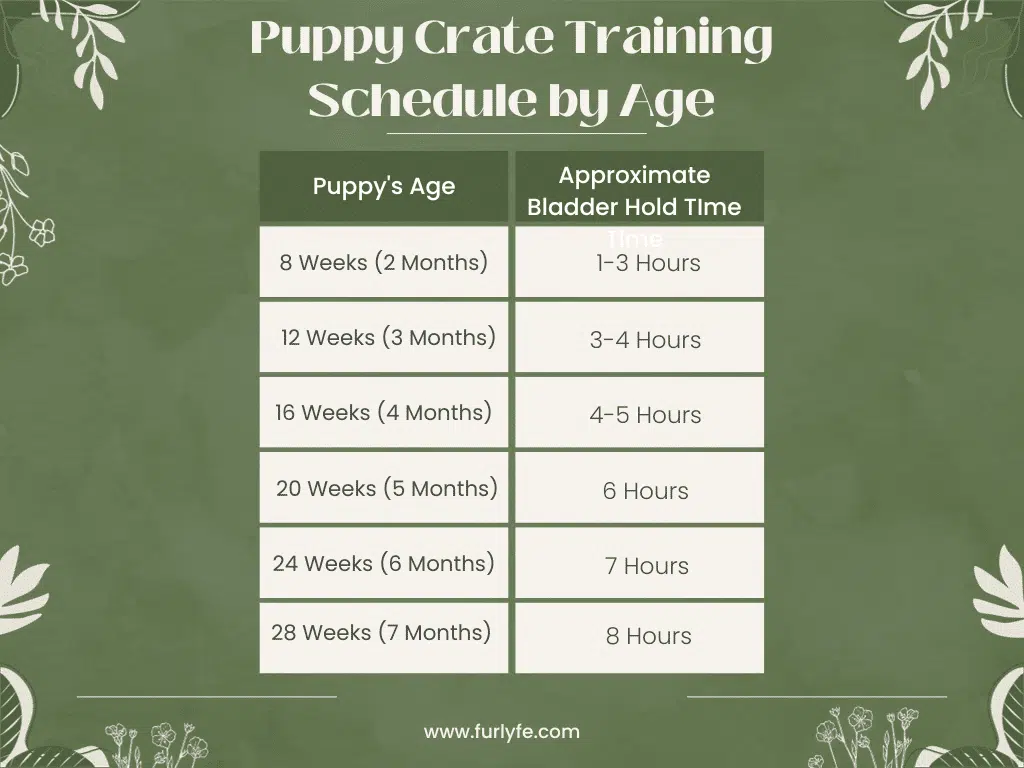1. Introduction
Crate training is a pivotal aspect of pet care, especially for larger breeds like the Bernese Mountain Dog. It’s a practice that, when implemented thoughtfully, can significantly benefit both the dog and the owner. For the Bernese Mountain Dog, a breed known for its affable nature and sizable stature, crate training is not just about instilling discipline; it’s about providing a safe, personal space. Understanding the importance of this training and its specific advantages for Bernese Mountain Dogs sets the stage for a successful and harmonious owner-pet relationship.
The essence of crate training lies in its multifaceted benefits. It aids in potty training, as dogs naturally avoid soiling their sleeping quarters. It also serves as a safe haven for the dog, a place where they can retreat to for rest and relaxation. For dog owners, it offers peace of mind, especially when the dog is left alone at home, reducing the risk of destructive behaviors or accidents. Additionally, it simplifies travel, making it safer and more comfortable for the dog to accompany their owners on trips.
2. Understanding Bernese Mountain Dogs
Before delving into the specifics of crate training, it is essential to understand the unique attributes of Bernese Mountain Dogs, as their characteristics significantly influence the approach to training.
Character Traits and Temperament
Bernese Mountain Dogs are known for their gentle, friendly demeanor. They are incredibly loyal and develop strong bonds with their family members. This breed is also known for its intelligence and willingness to please, which can make training a relatively smooth process. However, their sensitive nature means they respond best to positive reinforcement and gentle guidance. Harsh methods or negative reinforcement can lead to fear and mistrust, hindering the training process.
Their large size and strength require a firm yet compassionate training approach. Consistency in training and clear communication of expectations are vital. Understanding their temperament is key to tailoring the crate training process to be as stress-free and effective as possible.
Physical Characteristics and Size Considerations
An adult Bernese Mountain Dog can weigh anywhere from 70 to 115 pounds, with males typically being larger than females. Their size is a crucial factor in choosing the right crate. The crate must be large enough for them to stand up, turn around, and stretch out comfortably. However, it shouldn’t be excessively large, as a crate that’s too spacious might not provide the sense of security and coziness dogs usually seek in their den-like spaces.
Their thick, long fur, a characteristic feature of the breed, also plays a role in their comfort within the crate. Ensuring a large crate has proper ventilation and a comfortable temperature is crucial to prevent overheating, especially in warmer climates or during summer months. The selection of bedding material within the crate should also consider their fur; materials that offer a cool, comfortable resting place are preferable. Learn more from the American Kennel Club.
3. Choosing the Right Crate
Selecting the best dog crate for a Bernese Mountain Dog is a critical decision that impacts the success of the training process. The right crate not only ensures the comfort and safety of the dog but also facilitates a positive crate training experience.
Factors in Selecting Crate Size and Material
Given the Bernese Mountain Dog’s substantial size, the crate must be spacious enough to accommodate their full-grown stature. The ideal crate size should allow the dog to stand without hunching, turn around comfortably, and lie down stretched out. A general guideline is to choose a crate that is approximately 48 inches in length. However, individual measurements of the dog should be taken into account for a more tailored fit.
The crate’s material is also a crucial consideration. There are various options available, including wire, plastic, and fabric. Wire crates are popular due to their durability and ventilation. They often come with adjustable partitions, which can be useful for growing puppies.
Plastic crates offer more seclusion and are preferred for travel, but they might lack adequate airflow, especially for a dog with a thick coat like the Bernese Mountain Dog. Fabric crates are lightweight and portable but might not withstand the strength and chewing tendencies of a large, powerful dog.
Ensuring Comfort: Bedding and Toys
The crate should be a place of comfort and security for the Bernese Mountain Dog. Adding a comfortable, durable dog bed is essential. The crate pad bedding should be easy to clean or replace, considering that puppies, in particular, might have accidents during the early stages of crate training. Avoid excessively fluffy beds as they can get too warm and might not offer the support a large dog needs.
To further enhance the crate’s appeal, include safe, durable toys. Toys can provide mental stimulation and comfort, especially when the dog is left alone. However, it’s important to choose toys that are appropriate for the crate sizes, dog’s size and chewing habits to prevent any choking hazards.
For a personal touch, adding an item with the owner’s scent, like a worn t-shirt, can be comforting for the dog, particularly during the initial adjustment period. This can help the pup reduce anxiety and create a positive association with the crate.
4. Preparing for Crate Training
The preparation for crate training is as crucial as the training itself, particularly for a breed like the Bernese Mountain Dog, known for its size and sensitivity. Proper preparation sets the stage for a smooth and successful crate training experience.
Setting Up the Crate in Your Home
Choosing the right location for the crate in your home is essential. The area should be quiet enough to offer a peaceful retreat, yet not too isolated, allowing the dog to feel part of family activities. A corner in a living room or a spot in a family room where people frequently gather can be ideal. Avoid placing the crate in direct sunlight, near a heat source, or in a drafty area to ensure the dog’s comfort.
Ensure that the dog safe crate is set up in a way that is inviting and secure. If using a wire crate, consider covering it with a light blanket or crate cover to create a den-like atmosphere, which can be comforting for dogs. However, make sure there’s adequate ventilation to prevent overheating, especially for a thick-coated breed like the Bernese Mountain Dog.
Positive Introduction to the Crate
Introducing your Bernese Mountain Dog to their crate should be a positive experience. Start by letting them explore the crate at their own pace without forcing them in. You can encourage exploration by placing treats and their favorite toys near and inside the crate. The goal is to make the crate an appealing place to be.
Training sessions should be short and sweet, especially in the beginning. Praise and reward your dog for entering the crate, gradually introducing commands like “crate” or “bed” to associate the action with the crate.
Adjusting to the Crate
Every dog is different, and some may take longer to adjust to the crate than others. It’s important to be patient and not rush the process. If your Bernese Mountain Dog seems hesitant, take a step back and slow down the training. Never force them into the crate, as this can lead to negative associations and fear.
For puppies or dogs not used to confinement, start with short periods in the crate while you are at home. Gradually increase the time as they become more comfortable. Always ensure they have had enough exercise and an opportunity to relieve themselves before any extended period in the crate.
By preparing thoughtfully for crate training and introducing the crate in a positive, gentle manner, you lay the groundwork for a smooth and effective training process. This approach is particularly beneficial for Bernese Mountain Dogs, helping them adapt to the crate as a safe, enjoyable space.
5. Training Process
The crate training process for a Bernese Mountain Dog involves gradual steps, consistency, and a lot of patience. Understanding the breed’s temperament and needs is crucial in making this process stress-free and effective.
Initial Steps: Acclimatizing Your Dog to the Crate
Begin by encouraging your dog to spend short periods in the crate while you are at home. Start with a few minutes and gradually increase the duration. It’s important not to rush this process; some dogs may take days or even weeks to feel comfortable in their crate.
Use treats and their favorite toys to lure them into the crate. Each time they enter the crate, use a consistent command like “crate” or “bed” and reward them with a treat. This positive reinforcement helps them associate the crate with pleasant experiences.
Leave the crate door open during the initial stages so your dog doesn’t feel trapped. Watch for signs of stress or anxiety, such as panting, whining, or pacing. If these occur, shorten the crate time and try again later. It’s vital to ensure that each experience with the crate is positive.
Progression: Increasing Time Spent in the Crate
As your Bernese Mountain Dog becomes more comfortable with the crate, you can start closing the door for short periods. Stay nearby at first, gradually increasing your distance and the time your dog spends in the crate with the door closed.
During this phase, it’s essential to keep an eye on their behavior. If they remain calm, you can gradually start leaving the room for brief periods. However, if they show signs of distress, reduce the time and go back a step in the training process.
At this stage, it’s also a good idea to start incorporating crate time into their daily routine. For instance, crate your dog for short periods when you’re preparing meals or doing household chores. This helps them understand that crate time is a regular, normal part of their day.
Utilizing Positive Reinforcement Techniques
Positive reinforcement is key in crate training. Praise your dog warmly when they enter the crate on their own or stay calmly in the crate. Treats can be a powerful tool in reinforcing good behavior. However, it’s important not to overfeed them, especially considering the Bernese Mountain Dog’s size and potential for weight gain.
In addition to treats, consider using toys crate games or chew bones that are safe and engaging for your dog while they are in the crate. This not only keeps them occupied but also helps in reducing any anxiety or boredom.
Remember that crate training is not an overnight process, especially for a large and sensitive breed like the Bernese Mountain Dog. Patience, consistency, and positive reinforcement are essential in ensuring that your dog views the crate as a safe, comfortable, and enjoyable space.
6. Dealing with Common Challenges
Crate training a Bernese Mountain Dog, like any other breed, can present challenges. Understanding and effectively addressing these issues is crucial for a successful training process.
Addressing Separation Anxiety: Separation anxiety is common in dogs, particularly in a breed as people-oriented as the Bernese Mountain Dog. Signs of separation anxiety include excessive whining, barking, drooling, or destructive behavior when left alone. To help your dog overcome these issues:
- Start with Short Absences: Begin by leaving your dog in the crate for very short periods while you are in another room. Gradually increase the time you are away as your dog becomes more comfortable.
- Create Positive Associations: Leave a special toy or treat in the crate that they only get when you’re gone. This can help your dog associate your absence with something positive.
- Keep Departures and Arrivals Low-Key: Avoid overexcited greetings or farewells. This helps to downplay the significance of your comings and goings.
- Exercise and Mental Stimulation: Ensure your dog gets plenty of exercises and mental stimulation before crating. A tired dog is usually more relaxed and may sleep through your absence.
Overcoming Resistance to the Crate: Some dogs may initially resist entering or staying in the crate. To address this:
- Reintroduce the Crate Slowly: If your dog shows resistance, take a step back in the training process. Make the crate as inviting as possible and use treats and toys to encourage voluntary entry.
- Avoid Forcing Your Dog: Never force your dog into the crate, as this can create negative associations and increase their resistance.
- Consistent Training: Stick to a consistent training schedule. Dogs thrive on routine, and a consistent approach can help reduce resistance.
Responding to Whining or Barking: It’s not uncommon for dogs to whine or bark when first getting used to the crate. To handle this:
- Do Not Reward the Behavior: Avoid letting your dog out of the crate while they are whining or barking, as this can reinforce the behavior. Wait until they are quiet before opening the crate.
- Check for Basic Needs: Ensure that your dog’s basic needs (such as needing to go outside, hunger, or thirst) are met before crating them.
- Desensitization: Gradually acclimate your dog to longer periods in the crate. Use a calm and reassuring tone to soothe them if they start to whine or bark.
Preventing and Addressing Boredom: A bored dog can become restless or anxious in a crate. To prevent boredom:
- Provide Suitable Toys: Offer toys that are safe and engaging, such as puzzle toys filled with treats or long-lasting chews.
- Regular Exercise: Ensure your dog has plenty of physical and mental exercise throughout the day. A well-exercised dog is more likely to rest calmly in their crate.
By understanding and addressing these common challenges with patience and consistency, crate training your Bernese Mountain Dog can become a more smooth and rewarding experience. Remember, each dog is unique, and what works for one may not work for another. Flexibility and adaptation to your dog’s individual needs are key.
7. Balancing Crate Time with Exercise
For a breed like the Bernese Mountain Dog, balancing time spent in the crate with adequate exercise is crucial for their physical and mental well-being. This large, active breed requires regular physical activity to maintain health, happiness, and to prevent behavioral issues.
Importance of Regular Physical Activity:
- Physical Health: Regular exercise is vital for maintaining the muscular and cardiovascular health of your Bernese Mountain Dog. Given their size and propensity for certain health issues like hip dysplasia, keeping them fit and active is essential for their overall health.
- Mental Stimulation: Exercise provides mental stimulation, which is just as important as physical activity. A mentally stimulated dog is less likely to exhibit destructive behaviors or anxiety.
- Energy Management: A Bernese Mountain Dog puppy, can have a lot of energy. Adequate exercise helps to expend this energy in a positive way, leading to a more relaxed demeanor when it’s time to be crated.
Suggested Exercise Routines for Bernese Mountain Dogs:
- Daily Walks: Regular, brisk walks are essential. Due to their size, a minimum of 30-60 minutes of walking per day is recommended for adult dogs. This can be split into two or more walks.
- Playtime: Engage your dog in play activities that stimulate both their mind and body. Fetch, tug-of-war, and interactive toys are great options.
- Training Sessions: Incorporate training sessions into your exercise routine. This can include obedience training, agility exercises, or learning new tricks, which provide mental stimulation as well as physical exercise. The crate can also be used as a tool to potty train.
- Socialization: Visits to a dog park or play dates with other dogs can provide both socialization and physical activity. Ensure any interactions are supervised and that your dog is comfortable and safe.
Balancing Crate Time and Exercise:
- Exercise Before Crating: Before your dog spends a significant amount of time in the crate, make sure they have had a good amount of exercise. This can help them relax and be more comfortable settling down.
- Schedule Regular Breaks: If your dog needs to be in the crate for an extended period, schedule breaks for them to stretch, move around, and relieve themselves.
- Observe Your Dog’s Needs: Be observant of your dog’s behavior and energy levels. Some days they may need more or less exercise, and their needs can change as they age.
Crate Training for Different Scenarios (Travel, Guests, etc.): Crate training can be incredibly useful in various scenarios:
- Travel: Acclimate your dog to being in a crate during car travel. This makes trips safer and less stressful for both of you.
- Hosting Guests: If your dog gets overly excited or anxious around guests, having them stay in their crate with a favorite toy can help manage their behavior and stress levels.
- Recovery Space: After surgery or during illness, a crate can provide a safe and quiet place for your dog to recover, keeping them from overexertion.
Balancing crate time with adequate exercise is a key aspect of a holistic approach to your Bernese Mountain Dog’s care. It ensures that while they are benefiting from the structure and safety of crate training, they are also getting the physical activity and mental stimulation necessary for their health and happiness.
8. Common Myths Debunked
When it comes to crate training, especially for a breed like the Bernese Mountain Dog, there are several myths and misconceptions that can mislead or deter owners. Debunking these myths is crucial for a clear understanding and successful implementation of crate training.
Myth 1: Crate Training is Cruel
- Reality: When done correctly, crate training is not cruel. It creates a personal, safe space for your dog. Dogs have a natural instinct for a den-like space, and a crate can fulfill this need, offering a place for rest and security.
Myth 2: Dogs Shouldn’t Be Crated for Long Periods
- Reality: While it’s true that dogs shouldn’t be crated for excessive periods, a properly trained dog can stay in a crate for a reasonable duration without distress. This includes overnight or while the owner is at work, provided the dog has been exercised and has access to water.
Myth 3: Crates Are Only for Puppies
- Reality: Crates are beneficial for dogs of all ages. For adult and senior dogs, a crate can be a familiar and comfortable place to retreat. It’s also useful for managing behavior and providing a safe space in various situations, like travel or recovery from surgery.
Myth 4: Once Crate Trained, Always Crate Trained
- Reality: Dogs’ behaviors and needs can change over time. Continuous reinforcement and occasional retraining might be necessary, especially after changes in the household or the dog’s routine.
Myth 5: Crate Training is a Quick Process
- Reality: Crate training requires time and patience. The duration varies for each dog, depending on their age, temperament, and past experiences. Expecting immediate results can lead to frustration and setbacks.
Understanding these truths helps in approaching dog crate training with realistic expectations and a humane mindset. It underscores the importance of patience, consistency, and a positive approach in crate training a Bernese Mountain Dog.
9. Conclusion
Successfully crate training your Bernese Mountain Dog is a rewarding journey that enhances both your dog’s sense of security and your peace of mind. This comprehensive guide has covered various aspects of crate training, from understanding your dog’s unique needs to addressing most dogs’ common challenges and ensuring their health and safety in the crate.
Recap of Crate Training Benefits:
- Provides a Safe Haven: The crate becomes a safe, personal space where your dog can relax and feel secure.
- Aids in House Training: Crate training is an effective tool to potty train your pup, especially for puppies, as dogs naturally avoid soiling their sleeping area.
- Facilitates Travel and Management: A crate-trained dog is easier to manage during travel and in situations where confinement is necessary for safety or behavior management.
- Reduces Anxiety: For dogs prone to anxiety, the crate can be a comforting space, reducing stress during your absence or in unfamiliar environments.
Encouraging Consistent Training:
- Patience is Key: Remember that every dog is different, and some may take longer to adjust to crate training. Patience and consistency are crucial.
- Positive Reinforcement: Always use positive reinforcement to encourage your dog to view the crate as a positive space.
- Regular Reassessment: As your dog grows and their needs change, be prepared to reassess and adjust your crate training approach.
Final Thoughts: Crate training, when approached with understanding, patience, and consistency, can significantly improve the quality of life for both you and your Bernese Mountain Dog. It’s not just about providing a space for your dog to stay; it’s about creating a haven of comfort and security for them. As you continue on your journey with your Bernese Mountain Dog, remember that crate training is a process, one that evolves and changes just as your dog does.
FAQs
- How long should I crate train my Bernese Mountain Dog each day?
- The duration depends on your dog’s age and comfort with the crate. Puppies typically need shorter crate times (1-2 hours) while adult dogs can stay longer, especially if they are accustomed to it. Always ensure they have enough exercise and bathroom breaks.
- The duration depends on your dog’s age and comfort with the crate. Puppies typically need shorter crate times (1-2 hours) while adult dogs can stay longer, especially if they are accustomed to it. Always ensure they have enough exercise and bathroom breaks.
- Is it cruel to crate train a Bernese Mountain Dog?
- No, when done correctly, crate training is not cruel. It provides a safe, personal space for your dog and can aid in their overall training and well-being. The key is to ensure the crate is a positive, comfortable environment.
- What should I do if my dog doesn’t like the crate?
- Reintroduce the crate slowly. Make it inviting with comfortable bedding and favorite toys. Use treats and positive reinforcement to create a positive association with the crate. Never force your dog into the crate.
- Can crate training help with separation anxiety?
- Yes, crate training can be part of managing separation anxiety. It provides a safe space for your dog when you are not around. However, if your dog has severe anxiety, consult a professional for a comprehensive approach.
- How do I know when my dog is crate trained?
- Signs of successful crate training include your dog entering the crate willingly, appearing relaxed inside, and not showing signs of stress or anxiety. They should also be able to stay in the crate calmly for a reasonable duration.
- At what age can I start crate training my Bernese Mountain Dog?
- You can start as early as 8-10 weeks old. Begin with short periods and gradually increase the time as the puppy gets more comfortable with the crate.
- What if my Bernese Mountain Dog continues to soil the crate?
- This may indicate that they are being left in the crate too long without bathroom breaks, or it could be a sign of a health issue. Consult your veterinarian and make sure you are allowing enough bathroom breaks.
- Can my Bernese Mountain Dog sleep in the crate at night?
- Yes, many dogs sleep in their crates at night. Make sure the crate is comfortable with proper bedding and that your dog can easily access it when it’s time to sleep.

















Get involved!
Comments